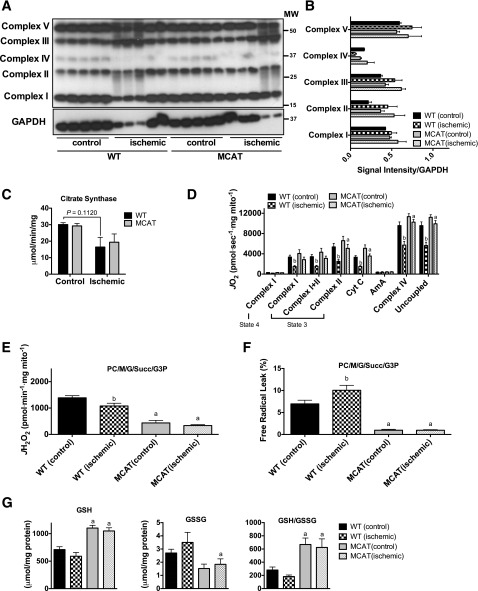Figure 7.
MCAT rescues mitochondrial respiratory function, decreases H2O2 emission, and maintains the cellular redox state in ischemic limb muscle. A: Western blotting for mitochondrial ETS proteins on control and ischemic limb EDL muscle from WT and MCAT mice (n = 5/group). B: Densitometry of Western blotting shows no genotype or ischemia effects on the abundance of proteins in the ETS. C: Citrate synthase activity was also not different between WT and MCAT mice (n = 5/group). D: High-resolution respirometry experiments performed on isolated skeletal muscle mitochondria show that the respiratory capacity was significantly lower in WT ischemic limbs compared with WT control limb muscle mitochondria (n = 8/group), which was rescued in the ischemic limb mitochondria from MCAT mice. E: Mitochondrial H2O2 emission under state 4 conditions with 25 μmol palmitoyl carnitine, 10 mmol glutamate, 2 mmol malate, 10 mmol succinate, and 10 mmol glycerol-3-phosphate was substantially lower in both control and ischemic limbs of MCAT mice, consistent with increased scavenging by catalase overexpression (n = 8/group). F: Free radical leak (%), calculated by normalizing data from E by state 4 JO2 measured in parallel experiments under identical substrate conditions, was also lower in the control and ischemic limbs of MCAT mice compared with WT mice (n = 8/group). G: GSH was significantly higher in the control and ischemic limb muscle of MCAT mice compared with that of WT mice; GSSG, oxidized form, was lower in both control and ischemic limbs of MCAT mice compared with those of WT mice, although statistical significance was only achieved in the ischemic limb; and the GSH/GSSG ratio was substantially higher in MCAT control and ischemic muscle compared with WT muscle, but no effect of ischemia was detected in either group (n = 5/group). Data are mean ± SEM and were compared with two-way ANOVA followed by Tukey posttest or two-tailed Student t test. aP < 0.05 for genotype effect, bP < 0.05 for ischemia effect. AmA, antimycin A; Complex I(state 3), glutamate + malate + adenosine diphosphate; Complex I(state 4), glutamate + malate; Complex I+II(state 3), glutamate + malate + adenosine diphosphate + succinate; Complex II(state 3), glutamate + malate + adenosine diphosphate + succinate + rotenone; Complex IV, ascorbate + N,N,N',N'-tetramethyl-p-phenylenediamine; Cyt c, cytochrome c; G, glutamate; G3P, glycerol-3-phosphate; M, malate; MW, molecular weight; PC, palmitoyl carnitine; Succ, succinate; Uncoupled, carbonyl cyanide-4-(trifluoromethoxy)phenylhydrazone.

